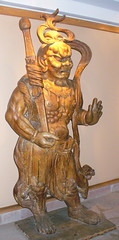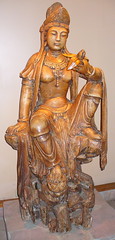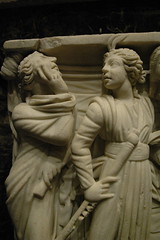“In retrospect, historians are usually right.” — Der Spiegel interviewer (11-11-08).
This has been a lively month for history blogging, for some obvious reasons — the election, the economic turmoil — and despite the mid-semester doldrums that often strike this time of year. I will, because I can’t leave well enough alone, be decorating this carnival with images from my collection.1
Hot Topics
Perhaps the first and foremost historical issue on everyone’s (well, every pundit’s) mind is the question of whether we’re in for another Great Depression.2 This has sparked a great debate about just what the Great Depression really was and how we got out of it: one of the great front-line battlers in this has been Americanist and Depression-expert Eric Rauchway, whose work has been cited by Paul Krugman, among others. On the other side3 , I’d recommend the Liberty & Power bloggers like Steven Horwitz
The election was, indeed, historic — yes, I hate that use of the word as much as you do, but at least it answered some of our questions. For context, Dmitri Minaev provides Russian and Soviet reporting on the 1908 election and 1933 crisis. Speaking of 1933, Greg Laden has a cautionary tale about FDR and unguarded statements about presidential preferences. Kristan Tetens gives us a look at the painting behind the phrase “audacity of hope.” Speaking of audacity, it’s hard to beat the story of the guy who ran for president from prison, Eugene Debs.
Another popular discussion has been the new Life Magazine collection hosted by Google Images: you can see examples here, here and here, among others. Speaking of photographs, one of the advantages of digital collections is that they might be less prone to accidental disposal4
 Meanwhile, there is a very serious discussion of historical revisionism and resurgent nationalism going on in Japan, inspired by the case of Japanese Self Defense Force General Tamogami who published — with the collusion of a right wing publisher — an essay arguing for Japan’s fundamental innocence in the initiation of World War Two. In addition to being lousy history, it violates the tradition of political neutrality by the post-war Japanese military and supports the idea of a revitalized pre-war nationalism unrestrained by the pacifist constitution or reality. Roy Berman has been on the case from early on and keeps digging up more great material. This is, for those of you unfamiliar with the Asian debates, roughly equivalent to the “Lost Cause” Civil War narratives which won’t go away, either. For some good WWII Pacific history, Elementaryhistoryteacher has a detailed discussion of the movie Beach Red and the post-battle history of the Battle of Tawara that inspired it.
Meanwhile, there is a very serious discussion of historical revisionism and resurgent nationalism going on in Japan, inspired by the case of Japanese Self Defense Force General Tamogami who published — with the collusion of a right wing publisher — an essay arguing for Japan’s fundamental innocence in the initiation of World War Two. In addition to being lousy history, it violates the tradition of political neutrality by the post-war Japanese military and supports the idea of a revitalized pre-war nationalism unrestrained by the pacifist constitution or reality. Roy Berman has been on the case from early on and keeps digging up more great material. This is, for those of you unfamiliar with the Asian debates, roughly equivalent to the “Lost Cause” Civil War narratives which won’t go away, either. For some good WWII Pacific history, Elementaryhistoryteacher has a detailed discussion of the movie Beach Red and the post-battle history of the Battle of Tawara that inspired it.
Women in Histories
The election was also noteworthy for the women who were involved — Hilary Clinton and Sarah Palin as candidates and Michelle Obama as the second First Lady with a law degree — and there are some serious political women in this month’s collection.
First, two stories of women running for office. Jennie W presents Helen Gahagan Douglas, who ran against Nixon for a US Senate seat and lost; she presents both pro-Nixon and anti-Nixon recollections of the campaign, which makes for an interesting historiographical exercise! Elizabeth K. Mahon gives us a “scandalous” tale of Presidential candidate Victoria Woodhull, who ran a half-century before women won sufferage in this country! Speaking of scandal, Andrew Amelinckx found a great scam artist.
Perhaps my favorite in this category is Liz Henry’s translation of Alfredo Arteaga’s anti-feminist poem, because she puts it in the context of Argentinian Feminists in the Early 1900s, so you can see that there was something interesting going on.
Going back a bit, this discussion of birth control in Rome is absolutely fascinating, including a menstruation-inducing herb that was so heavily harvested that it is now extinct. There’s a bit of environmental and women’s history that didn’t make it into my current textbook!
Because China’s Big

Alan Baumler reports on an attempt to create a Virtual Forbidden City for teaching purposes, but it’s got limits. Morgan Pitelka visits Second Life to confer with folks exploring new frontiers in New Media and Japanese Studies. Chris Bertram, though, meditated on older Chinese technology and the memories and connections it leaves behind.
History is very much about the recovery of memory. Gina, our newest member at Frog in a Well: China, raises interesting questions about lost stories of the Cultural Revolution and how new texts can bring them to life. Going back further, how many of us teaching World or Western history remember to mention that there were Chinese in the Great War? Thousands and thousands of them, but it wasn’t enough to get Chinese issues a fair hearing afterwards. Shortly after that, Bertrand Russell visited China and wrote some very perceptive things.
I know it’s not China but…. John P. DiMoia raises some fascinating issues in the history of science, and nationalism, looking at a cholera outbreak in South Korea in the early days of the US occupation.
The Atlantic Has Two Sides
There was quite a bit submitted this time around which features trans-Atlantic connections, sometimes unexpectedly. For example, this photoessay of a New York City park features a park named after a British colonial governor, a playground named after an American female entrepreneur, and cobblestones made from ship ballast. This description of procedure in the British House of Commons at the beginning of the previous century notes the degree to which US founders were influenced by British parliamentary practice.
There was some actual travel, or at least legends of actual travel: Eliza Knight gives us St. Brendan, the Celtic priest who may have visited North America before even the Vikings. A blog devoted to 300-word historical fiction vignettes offers Charles Lindbergh’s immigrant ancestor.
And in a more verifiable holiday vein, Hari Balasubramanian revisits Thanksgiving in the light of 1491.
He Who Laughs Last
Fiona Veitch Smith presents Pantomime theatre, a venerable but evolving British tradition featuring cross-dressing, current events satires and much more.
And, one of my favorite posts of the month, Scott Eric Kaufman presents a slice of comic strip history, Charlie Brown v. Dennis the Menace (also here, with more comments). Why is it one of my favorites? I never liked Dennis the Menace….
Looking Ahead
That was fun! Hope the end of your semester is, if not painless, at least crisis-free, and your holidays joyous! The next History Carnival host is Melissa Bellanta at The Vapour Trail. You can submit nominations through The History Carnival website, or with del.icio.us tag or the old Blogcarnival.com page.
collected shamelessly for educational purposes from museums (the Nelson-Atkins in Kansas City), parks (Fort Scott, Kansas) and private collections (Waikoloa Hilton, Hawai’i). Fair use applies: if you find any of this useful, feel free to use it as appropriate, giving credit where credit is due. ↩
Sometimes, I’d rather not be right ↩
though it’s not entirely clear how many “sides” there are here ↩
if you do regular backups and use good hosting services! ↩









Thanks for the link plus the other great articles. I’m heading over to check out St Brendan now …
What a most enjoyable carnival! Thank you for the link and I can’t wait to read these fabulous other articles.
Cheers!
Eliza
Thanks for the link and great job hosting the carnival! I just wish the History Carnival button was displaying properly in the html at my site!